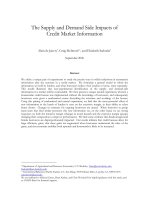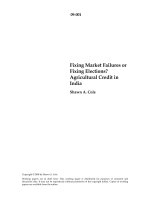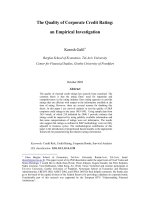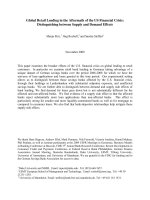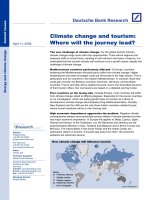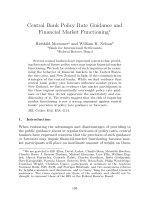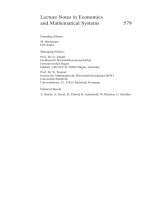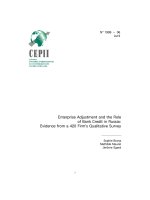POLICY REGIME CHANGE AND CORPORATE CREDIT IN BULGARIA: ASYMMETRIC SUPPLY AND DEMAND RESPONSES pdf
Bạn đang xem bản rút gọn của tài liệu. Xem và tải ngay bản đầy đủ của tài liệu tại đây (610.85 KB, 33 trang )
THE WILLIAM DAVIDSON INSTITUTE
AT THE UNIVERSITY OF MICHIGAN BUSINESS SCHOOL
POLICY REGIME CHANGE AND CORPORATE CREDIT IN
BULGARIA: ASYMMETRIC SUPPLY AND DEMAND RESPONSES
By: Rumen Dobrinsky and Nikolay Markov
William Davidson Institute Working Paper Number 607
September 2003
POLICY REGIME CHANGE AND CORPORATE CREDIT IN
BULGARIA: ASYMMETRIC SUPPLY AND DEMAND RESPONSES
*
Rumen Dobrinsky
a
and Nikolay Markov
b
a
UN Economic Commission for Europe; Palais des Nations, CH-1211 Geneva, Switzerland
tel. (+41 22) 917 2487; fax: (+41 22) 917 0309; e-mail:
b
Centre for Economic and Strategic Research; 3 akad. Nikola Obreshkov street, apt. 1;
Sofia-1113, Bulgaria, tel./fax: (+359 2) 971 3267; 973 2905; e-mail:
*
The Centre for Economic and Strategic Research gratefully acknowledges financial support
for this research from the European Commission (PHARE-ACE project P98-1125-R) and
from the CERGE-EI Foundation (under a program of the Global Development Network,
2002). The views expressed in this paper are those of the authors and not necessarily of the
organizations they are affiliated with.
POLICY REGIME CHANGE AND CORPORATE CREDIT IN BULGARIA:
ASYMMETRIC SUPPLY AND DEMAND RESPONSES
ABSTRACT
The paper seeks to assess how a major policy regime change – such as the introduction
of the currency board in Bulgaria – affects the flow of bank credit to the corporate sector. An
attempt is made to identify the determinants of corporate credit separately from the viewpoint
of lenders and borrowers. The estimated credit supply and credit demand equations provide
empirical evidence of important changes in microeconomic behavioral patterns which can be
associated with the policy regime change. The results also suggest a considerable asymmetry
in the response of credit supply and credit demand to the policy shock: while the supply shifts
were quite pronounced, the patterns of firms’ credit demand remained fairly stable. The policy
implications of the detected asymmetry in microeconomic adjustment are also discussed in
the paper.
Keywords: corporate credit, credit supply and credit demand, regime change, currency board,
transition economy
JEL classification numbers: G21, G32, G38
1
POLICY REGIME CHANGE AND CORPORATE CREDIT IN BULGARIA:
ASYMMETRIC SUPPLY AND DEMAND RESPONSES
1. Introduction
Bulgaria’s difficult transition from plan to market was marked by persistent
macroeconomic and financial instability leading to a major economic collapse in 1996-1997.
In 1997 a currency board arrangement (CBA) was established as a “policy of last resort” with
the aim to impose fiscal and financial discipline. The change in the monetary regime was
accompanied by a comprehensive package of policy reforms affecting not only the
macroeconomic but also the institutional environment and the functioning of the financial
system. In particular, the norms of prudential bank lending and bank supervision were
tightened considerably; at the same time bankruptcy procedures were simplified and
streamlined. All in all this amounted to a major policy regime change, in fact, the most
important policy shift during the whole transition period.
It has been widely acknowledged that Bulgaria’s macroeconomic performance has
changed dramatically since 1997. Macroeconomic and financial stability have been restored
and economic activity started to recover; inflation was brought down to single-digit numbers,
real incomes have been rising and the chronic fiscal gap has been closed. A CBA is an
extremely rigid macroeconomic regime which hardens macro-budget constraints as it
eliminates direct central bank credits to finance the budget deficit. It also hardens micro-
budget constraints, in the first place in the banking system, as the central bank can no longer
engage in refinancing commercial banks. However, so far there has been relatively little
research on how this policy regime change affects the relations between enterprises and banks
and the flow of bank credit to the firms, and whether it helps impose hard micro-budget
constraints in the corporate sector.
William Davidson Working Paper 607
2
This paper addresses some of the microeconomic implications of this policy regime
change, focusing on the flows of bank credit to the enterprise sector and analysing
independently the determinants of corporate credit from the side of lenders and borrowers. To
this effect we use results from the recent literature to formulate and specify equations
reflecting the motivation behind lending and borrowing decisions. These equations are
estimated econometrically using firm level data for Bulgarian firms for the period 1995-1999.
In analyzing the results we seek to identify changes in behavioral patterns which can be
associated with the change in the policy regime.
We find a considerable asymmetry in supply and demand responses. The most
important behavioral changes took place on the supply side, reflecting adjustments in bank
lending practices. By contrast, we observed little changes in the patterns of firms’ credit
demand that could be associated with the policy regime change. We suggest an interpretation
of these asymmetric supply and demand responses in terms of the outcomes of the 1997
policy reform in the banking and enterprise sectors.
2. The determinants of corporate credit: supply and demand aspects
2.1. Theoretical background
There are important distinctions and specificities in the motivation of lenders and
borrowers to engage in this process. However, while there is a considerable body of literature
dealing with the more general issue of corporate finance, relatively few publications deal
directly with the motivation of credit supply and demand.
One strand in the literature on corporate finance focuses on the role of bank-enterprise
relations in imperfect credit markets
1
claiming that banks are better positioned than other
1
In perfect markets firms are indifferent to the choice between internal or external sources of finance. Market
imperfections such as information asymmetries, incompleteness of contracts and principal-agent problems, add a
premium to the would-be cost of capital in a perfect market because banks incur monitoring, agency and
William Davidson Working Paper 607
3
creditors to collect relevant information on the actual state of firms (Diamond (1984), (1989);
Mayer (1988)). Banks are motivated to establish long-term relations with their clients as this
helps them to overcome the existing information asymmetries by providing the opportunity
for better monitoring; consequently, this reduces lending risk and costs. In turn, firms are also
motivated to enter into long-term relations with their creditors as lower lending risk reduces
borrowing costs. Hence the notion of relationship banking is a relevant one both when dealing
with credit supply and demand. Empirical studies on the topic have provided abundant
evidence in support of the conjecture that long-term enterprise-bank relations are important
determinants of bank lending (Cole (1998); Petersen and Rajan (1994)).
The so called portfolio approach to credit supply (for an overview see Fase (1995))
starts with the assumption that banks maximize a utility function under a set of balance sheet
constraints which allows to derive directly credit supply functions. However, the derivation
assumes a perfect financial market while treating the private sector (comprising the corporate
and household sectors) as one homogeneous entity. These limitations restrict the use of this
model when trying to address the specific issues related to corporate finance in imperfect
markets.
The demand for any type of credit – including firm’s demand for commercial bank
credit – can be analyzed within the context of money demand in the broader sense, an issue
which is well developed in economic theory. One of the more specific approaches to
corporate demand for commercial bank credit (Melitz and Pardue (1973), among others) is
based on the assumptions that credit demand is driven by the need to adjust the firms’ balance
transaction costs. The wedge between the costs of external and internal funds is a source of financial pressure for
the firms and may give rise to adverse selection and credit rationing on capital markets (Stiglitz and Weiss
(1981); Hubbard (1998)). Imperfect information, especially in a period of financial distress, may also induce
adverse selection due to the failure by the creditors to distinguish between viable and unviable firms (Mayer,
(1998)).
William Davidson Working Paper 607
4
sheets in accordance with the changes (including anticipated ones) in firms’ assets. Depending
on the maturity structure of the asset side, firms may have a preference towards financing
them with liabilities of a matching, or relevant, maturity structure. In this scheme, the demand
for corporate credit plays a special role as it sometimes may also serve as a buffer towards a
desired maturity structure.
One of our main goals in analysing the flows of corporate credit is to trace the effect
of a policy shock, such as the introduction of the CBA on the determinants of these flows.
The theoretical literature suggests that policy may have an effect on credit supply and demand
in various ways. Thus changes in monetary policy do affect banks’ and firms’ behavior due to
the existence of a transmission mechanism through which monetary shocks affect real
economic performance. The more traditional view of a money channel (or interest rate
transmission mechanism) implies that monetary shocks affect the economy through their
effect on interest rates (the cost of credit), which is basically a demand effect. Thus a
monetary contraction results in higher cost of (short-term) credit which causes the demand for
credit to fall; in turn, given that financial markets are imperfect, the lower inflow of financial
resources, affects firms’ performance. The recently advanced “credit channel view” implies
that monetary policy shocks affect real economic performance through the supply of credit by
financial intermediaries due to shifts in the supply schedule of the latter. In turn, the literature
makes a distinction between a “bank lending channel” which pertains to banks only and is
related to their dual nature of holders of deposits and generators of loans to firms and a “broad
credit channel” which treats the supply of external funds to firms by all financial
intermediaries (Oliner and Rudebusch (1996); Hu (1999)).
The credit channel view is also consistent with the assumption of the existence of
market imperfections, in particular, information asymmetries between borrowers and lenders
which give rise to the above mentioned monitoring cost premium (Gertler (1988); Hubbard,
William Davidson Working Paper 607
5
(1995)). One implication of the existence of a credit channel in the monetary transmission
mechanism is that it induces a heterogeneous response both of the credit market and of the
firms due to which the increase in the cost premium for external finance will not be uniformly
distributed across firms. The reason for this heterogeneity is the fact that the existing credit
market imperfections are likely to impact in a different manner on various categories of firms
in the event of a monetary shock. In particular, the credit channel view is consistent with the
empirical finding that the effect of a monetary shock should be more severe for small firms
(that are more likely to face information costs) than for large firms (Oliner and Rudebusch
(1996)) or that the negative effect of a monetary contraction on investment is greater for
highly leveraged firms (which are more likely to suffer a reduction in their collateralizable net
worth due to the monetary shock) than for less leveraged firms (Rondi et al. (1998); Hu
(1999)).
Various supply and demand effects may emerge due to the existence of transition-
specific market imperfections which feature the economies undergoing transition from plan to
market. In particular, corporate financial flows are seriously affected by the existence of “soft
budget constraints”. Initially the term soft budget constraints was used by Kornai (1980) to
denote paternalistic behavior on the part of the state in the ex-post bailing out of loss-making
state-owned enterprises (SOEs) that found themselves in financial distress. Later, the concept
was extended in different directions, in particular subsuming adverse selection in long-term
banking lending under imperfect information when banks are not capable of properly
distinguishing between profitable and unprofitable projects or, in more general terms, when
they face ex-ante inefficiency in financing but have ex-post benefits of refinancing (Berglof
and Roland (1998)). Having made an initial advance to an enterprise, a bank may continue
lending, treating losses as sunk costs and believing that further lending will increase the
overall net present value of the total investment beyond what may be realised if they stop
William Davidson Working Paper 607
6
financing the firm. A major difference between this concept and Kornai’s notion of soft
budget constraints lies in the ex-ante attitude of creditors. While creditors (in particular, the
state) explicitly bail out unprofitable firms (this information is available ex-ante), the adverse
selection in the second case is due to imperfect information: if the relevant information had
been available to the creditors ex-ante, they would have declined to finance the project
altogether (Schaffer (1998)). In reference to long-term enterprise-bank relations in a
transitional environment, it has been observed that relationship banking in imperfect markets
may also involve moral hazard and may give rise to soft budget constraints for the borrowing
firms.
Dobrinsky et al. (2001) conjecture that some specific types of soft budget constraints
in a transitional environment may emerge as a result of distortions in incentive structures. In
particular, distorted incentives may have an effect both on the determinants of credit supply
and credit demand.
2
In turn, incentive structures are a reflection of the institutional
environment and the conduct of economic policy in the broader sense. Consequently, policy
reforms and policy shocks can be expected to affect the determinants of credit flows both on
the supply and the demand side.
The empirical research in this area is confronted with one additional difficulty,
namely the absence of direct observations on supply and demand: observed bank lending only
provides information on the intersection points of the supply and demand curves which is not
sufficient to identify each of the two schedules. Most empirical studies on the issue try to
overcome the problem by assuming a leading role of one of the two sides, usually demand.
Other studies analyse bank credit in the broader context of enterprise finance without
2
For example, opportunistic behaviour on the part of banks may offset proper monitoring and screening on the
supply side. In turn, demand patterns may be driven by survival strategies rather than by viable business
strategies.
William Davidson Working Paper 607
7
attempting a distinction between supply and demand decisions (Cärare and Perotti (1997);
Dobrinsky et al. (2001)). Among the few empirical studies that explicitly distinguish between
credit supply and demand is that by Bratkowski, Grosfeld and Rostowski (2000) who analyse
the access to bank finance by new private firms in the Czech Republic, Hungary and Poland
on the basis of an enterprise survey. They overcome the above difficulty by using additional
exogenous information: a special question in the survey inquiring about the firms’ intention to
apply for bank credit which reflects credit demand proper.
We use these theoretical underpinning to specify estimable equations for the supply of
and demand for corporate credit. Since theory does not provide clues as to the possible
structural forms of these equations we basically rely on reduced forms. Data considerations, in
particular, the availability of relevant statistical data, also has played a certain role in the
specification of these equations.
In the absence of direct observations on supply and demand, observed bank lending
only provides information on the intersection of the supply and demand curves and this is not
sufficient to identify correctly each of the two schedules. The absence of additional
exogenous information on the supply and demand patterns does not allow to overcome the
ensuing simultaneity problems completely. We offer a partial solution to the problem by
carefully specifying the two types of equation and selecting specific sets of variables
depicting supply and demand factors. In addition we use interaction variables to partially
offset endogeneity effects.
2.2 Modelling credit supply
On the basis of the theoretical considerations outlined above, we have selected a set of
independent variables which are conjectured to reflect supply factors, determining the
willingness of banks to extend credit to firms. The rationale behind each such variable is
discussed below and actual specification of the credit supply equation has the following form:
William Davidson Working Paper 607
8
(1) C
i
= a
o
+ a
1
C
i
(-1) + a
2
PD
i
+ a
3
[C
i
(-1)*PD
i
] + a
4
FC
i
+ a
5
ED
i
+ a
6
S
i
+ a
7
DD
i
+ a
8
OD
i
+ε
i
,
where:
- C
i
is a binary variable defining the access to bank credit. It takes the value of 1 when
during the year there have been flows of bank credit from the banks to the firm.
- PD
i
is a profitability dummy which takes values of 1 when the firm’s operational
profitability P
i
> 0 and is 0 otherwise;
- [C
i
(-1)*PD
i
] is an interaction variable defined as the product of the lagged value of
C
i
and the profitability dummy;
- FC
i
is a fixed capital ratio defined as the share of fixed assets in the firm’s total
assets;
- ED
i
is a dummy for exporting firms. The dummy takes a value of 1 if in two out of
the three years for which export data were available the ratio “exports/sales” was larger that a
pre-defined threshold (30%), and is 0 otherwise;
- S
i
is a size variable defined as the market share of individual firms within NACE 2-
digit sectors;
- DD
i
is a delinquency dummy indicating the incidence of past financial indiscipline in
credit service among the firms that had access to bank credit. This variable takes the value of
1 in the case when there were incidents of payment arrears (in the sense of either principal or
interest, or both, being in arrears) in the firms’ credit record for the previous year;
- OD
i
stands for a set of dummy variables defining ownership based on four categories
of ownership (SOEs, firms privatized to domestic investors, other domestically owned private
firms and firms with foreign participation).
The rationale behind this specification of the credit supply equation is the following.
To avoid the endogeneity and reverse causality problems (the confusion of supply and
William Davidson Working Paper 607
9
demand factors) we have tried to exclude from the supply equation variables that may reflect
demand and may give rise to reverse causality. The backside is that the equation may be
curtailed.
The presence of the lagged dependent variable C
i
(-1) has a dual interpretation. On the
one hand, it reflects relationship banking in the vein of the literature discussed in section 2.1.
Long-term enterprise-bank relations help to reduce information asymmetries; banks would be
more willing to lend again if they have already done so (we consider the banking sector as a
whole as the lending party). On the other hand, a positive association can be interpreted as
evidence of soft budget constraints on the part of the banks in the sense of Berglof and Roland
(1998).
The rest of the variables reflect credit screening and monitoring by the banks as well
as the credit channel hypothesis. The profitability variable is intended to capture the
sensitivity of lending to the firm’s financial health (a test for adverse selection in bank
lending). The operational profitability of the firm can be regarded as a measure of its viability
so its presence allows to check whether banks are more inclined to lend to viable firms. This
coefficient is expected to have a positive sign (the opposite can be interpreted as evidence of
adverse selection).
Obviously, in this case we cannot fully eliminate the identification and causality
problem because firms’ profits/losses may affect their demand for credit as well. In order to
circumvent this problem (at least partly) we use in addition an interaction variable between
the profitability dummy and the lagged value of the access to credit variable. The rationale is
to test whether long-term enterprise-bank relations are associated with the firm’s viability.
The fixed capital ratio variable is aimed to capture the importance of collateral for the
supply of bank credit, which is an essential aspect of bank lending in the credit channel view.
Fixed assets can be used to collateralize bank loans and, in the case when collateral is an
William Davidson Working Paper 607
10
important determinant in banks’ decision to extend a credit, the more collateralable fixed
assets a firm has, the more likely it would be to have access to bank credit. As, in accordance
with the acting banking regulations in Bulgaria bank are required to take collateral, the prior
is that, in the case of proper screening, there would be a positive association between bank
lending and the fixed capital ratio. Size is another variable that would allow to test the credit
channel hypothesis. The prior is that a credit squeeze is more likely to affect smaller firms.
Several variables reflect the specificity of bank lending in a transitional environment.
Ownership is assumed to be associated with governance and thus should capture the way
governance affects banks’ lending decisions. The presence of the delinquency variable is
intended to capture the incidence of “soft lending” and/or distorted incentives in lending:
whether and how a history of financial indiscipline by the firms in their past borrowing affects
subsequent bank lending to these firms. The export variable is intended to check whether
exporting firms have higher credibility as borrowers of bank credit (which is the prior).
2.3 Modelling the demand for corporate credit
The specification of the credit demand equation is based on a generally defined money
demand function extended with in accordance with the conceptual approach outlined above.
The demand for credit in general, as a form of money demand, can be assumed to depend on
two main variables: the income or activity level and the cost of credit. In accordance with the
discussion in section 2.1, we augment this basic specification with variables mirroring the
adjustments in the firms’ balance sheets as well as such related to the specifics of this type of
financial flows. The actual specification of the credit demand equation is as follows (its
justification is discussed below):
(2) C
i
= a
o
+ a
1
C
i
(-1) + a
2
YD
i
+ a
3
(YD
i
* Large
i
) + a
4
(YD
i
* OD
i
) + a
5
ID
i
+
+ a
6
(ID
i
* Large
i
) + a
7
(ID
i
* OD
i
) + a
8
IvD
i
+ a
9
(IvD
i
* Large
i
) + a
10
(IvD
i
* OD
i
) +
William Davidson Working Paper 607
11
+ a
11
PD
i
+ a
12
LD
i
+ a
13
(PD
i
*LD
i
) + a
14
DR
i
+ a
15
R
j
+ ε
i
,
where:
- C
i
is the same binary variable as specified above.
- YD
i
is an income or activity dummy variable which takes the value of 1 if the change
of real sales over two subsequent years is positive (growing firms), and is 0 otherwise.
- Large
i
is a dummy variable for large firms. Three criteria are used for the
classification by size: total sales, total assets and employed labor. First the firms are broken
down into three subgroups by each of these criteria. For the final classification a firm is
defined as “large” (the dummy takes a value of 1) if it satisfies at least two of the three
criteria.
- ID
i
is a dummy for firms actively investing in fixed assets.
3
It takes the value of 1
either if the ratio of investment to sales in a given year is larger than the same ratio in the
previous year (firms with a growing investment share) or if the share of investment to sales is
greater than a pre-defined threshold (10% in our case), and is 0 otherwise. The idea behind
this definition is to identify those firms whose investment pattern in the given year is likely to
instigate demand for external finance, and we define two such categories of firms: 1) firms
whose investment pattern changes compared to the previous year; 2) firms with relatively
high levels of investment activity compared to other firms.
- IvD
i
is a second investment dummy variable reflecting investment in inventories. It
takes the value of 1 if the ratio of inventories to sales in a given year is larger than the same
ratio in the previous year (firms with a growing inventory share), and is 0 otherwise.
- OD
i
is the above specified set of ownership dummy variables.
- PD
i
is the profitability dummy specified above.
3
Due to the underdeveloped capital market, investment in financial assets by Bulgarian firms was virtually
negligible.
William Davidson Working Paper 607
12
- LD
i
is a dummy for firms facing liquidity constraints. The liquidity constraint
dummy is constructed as follows: it takes a value of 1 if the firm’s quick ratio (the ratio
between the sum of accounts receivable and liquid assets to the firm’s current liabilities) is
smaller than 1 (the critical level of the quick ratio) in the given year and is 0 otherwise.
- DR
i
is a variable reflecting the firm’s leverage, defined as the share of long-term debt
in the firm’s total assets.
- R
j
is a sector-specific real interest rate defined as the average annual nominal interest
rate on bank credit discounted by the sector-specific producer price index (defined at the
NACE 2-digit level).
The rationale behind this specification of the credit demand equation is as follows. We
do not have information about which firms actually asked for credit but only about those that
actually received it. Similarly to the credit supply equation, in order to avoid endogeneity
problems we have tried to exclude from the demand equation variables that may reflect
demand and may give rise to reverse causality.
In this case, similarly to credit supply, we also use the lagged value of C
i
but in this
case it is intended to capture habit persistence in credit demand. Admittedly, in this case the
reverse causality issue cannot be fully eliminated. YD
i
, ID
i
and IvD
i
are activity variables
which seek to reflect the effect on demand for external finance of a general expansion of
business activity and/or investment activity. The prior is for a strong positive association; a
weak statistical association between the dependent variable and these activity variables would
suggest the presence of distorted or perverse incentives (the demand for external funds is not
based on viable business and investment projects). In addition to using the activity variables
separately, we also interact them with size and ownership variables to account for possible
heterogeneity in credit demand among various categories of firms.
William Davidson Working Paper 607
13
PD
i
and LD
i
are aimed at testing the incidence of adverse selection: whether firms in
poor financial health and/or facing liquidity constraints are more likely to seek and get access
to bank credit. In the case of the liquidity dummy there is no ambiguity about the causality
and the interpretation of the results in terms of adverse selection. However, in the case of the
profitability dummy, again we cannot fully eliminate the endogeneity problem because – as
mentioned before – firm’s profit/loss position may affect also bank’s decision to extend the
loan. In order to get around the reverse causality issue and be able to capture the incidence of
adverse selection with respect to PD
i
we use the interaction variable (PD
i
*LD
i
) which
combines the profitability dummy with the variable related to financial strain.
The leverage variable DR
i
seeks to identify statistical association between the demand
for credit and indebtedness. The prior is that heavily indebted firms may be subject to
financial strain due to high servicing costs which may lead them to seek new credit. In turn, if
heavily indebted firms are more likely to get credit – which would be revealed by a positive
statistical association – this may be an indication of the incidence of soft budget constraints
on the part of the banks in the sense of Berglof and Roland (1998).
4
We have also included in the credit demand equation the variable R
j
, the sector-
specific real interest rate on bank credit.
5
The rationale is the following. Due to the nature of
transition from plan to market, during the period we are analysing, there has been
considerable realignment of relative prices across sectors of economic activity. Consequently,
firms belonging to different branches have been facing de facto different real costs of bank
credit which may have affected their demand for bank loans.
4
Obviously in this case we also have interference of supply and demand factors; however in this case the main
driving push definitely comes from the demand side.
5
When we estimate the credit equation using annual cross-section data, it is not possible to include the interest
rate proper in the equation as it is a constant.
William Davidson Working Paper 607
14
3. Empirical analysis of corporate credit under a policy regime change
The arguments outlined above suggest that a major policy shock such as the policy
reforms that accompanied the introduction of the CBA in Bulgaria should have considerable
repercussions on the flow of bank credit to the corporate sector. In the first place, the regime
change in monetary policy (which, among other things, eliminated direct central bank
refinancing of the banking system) is likely to have affected bank lending through both the
money and credit channels. Secondly, the important institutional and legislative changes can
be expected to have had a strong effect on incentive structures in the banking and enterprise
sectors, thus affecting both the supply and the demand side. However uncovering the actual
changes at the microeconomic level – such as the changes in borrowing and lending practices
– essentially remains an empirical issue. For this purpose we estimate the specified credit
supply and credit demand equations.
The prior is that the policy shock affected the underlying structural relations governing
the supply of and demand for bank credit. Accordingly, these changes can be expected to
show up in the parameters of the reduced form supply and demand equations. Hence our
research strategy is to estimate these equations for individual years (those before and after the
policy regime change) – rather than for the period as a whole – and to trace and analyze the
changes in the estimated parameters.
The empirical analysis is based on a comprehensive enterprise data set covering
corporate entities that report to the National Statistical Institute using the double entry
accounting method. The number of firms covered in this analysis for the period 1995-1999
William Davidson Working Paper 607
15
varies from some 8,400 firms in 1994 to more than 28,000 firms in 1999. Table 1 shows some
descriptive statistics for the sample for firms used in the estimation.
6
(table 1 here)
To take into account the behavioral impact of corporate governance we differentiate
between four ownership categories of firms: 1) SOEs; 2) Firms privatized to domestic
investors (former SOEs, in which domestic investors hold a majority stake at the moment of
reporting, and there is no foreign participation); 3) Other domestically owned private firms
(mostly de novo private firms), and 4) Firms with foreign participation (these are either
privatized or de novo firms; foreign investors may not have a majority stake).
The second and the third panels of table 1 reflect the firms’ access to bank credit.
These data provide evidence of a general credit crunch in the years immediately following the
introduction of the currency board caused by a withdrawal of the banks from lending to the
corporate sector. The evidence of changes in corporate performance in this descriptive
statistics is mixed. Thus average profitability was on the decline after 1997 while in terms of
sales growth, after an improvement in 1998 the situation deteriorated again in 1999. On the
other hand, there was a marked improvement in financial discipline: the share of firms with
arrears on bank credit rapidly declined after 1997 (the sixth panel).
3.1 Credit supply
The estimation results for this equation are presented in table 2. The equations were
estimated for each year from 1995 to 1999 using probit techniques. The Wald tests for
structural break for two subsequent years are highly significant suggesting instability of the
estimated relationship over time, a result that provides support for the approach based on
6
Due to the data requirements of the specified equations some firms form the data base had to be dropped from
the estimation. Table 1 reports only the data for those firms that contain the full statistical information used in
the estimation of the credit supply and demand equations.
William Davidson Working Paper 607
16
single year (rather than panel) estimations. The results of this test are also consistent with the
conjecture of ongoing changes in behavioral patterns during the period that we scrutinize.
(table 2 here)
In general, the estimation results are quite in line with the expectations based on
theoretical considerations; in addition they provide evidence of significant changes in the
motivation of bank lending which accompany the change in the policy regime.
The estimated coefficients can be divided in two groups, depending on their stability
over time. The first group consists of coefficients reflecting relative stability of the underlying
relations during this period. The estimation results highlight the importance of relationship
banking: the coefficient of the lagged dependent variable is positive and highly significant; its
absolute value also suggests that long term enterprise-bank relations are among the important
determinant of the supply of bank credit. On the other hand, as noted above, this result may
also be interpreted as evidence of the persistence of soft budget constraints. Another
coefficient that is always estimated as positive and highly statistically significant is size. This
is also in line with the prior that large firms are more likely to have access to bank credit than
smaller firms and is consistent with the credit channel hypothesis. The estimation results also
indicate that exporting firms are more likely to have access to bank credit than those that only
operate on the domestic market: with the exception of the results for 1997 this coefficient is
also estimated as positive and highly significant.
The profitability coefficient is also positive in all years but its statistical significance
declines somewhat in the last two years; the estimated coefficient also declines in absolute
value. However, counter to expectations, the coefficient of the interaction variable between
relationship banking and viability was not estimated as statistically significant. This might
suggests that while long-term enterprise-bank relations do matter for banks’ decisions (as it
follows from the estimated coefficient of the lagged dependent variable), the allocation of
William Davidson Working Paper 607
17
credit to firms with such relations was not necessarily associated with their present
profitability. The combination of these results implies that while profitability – hence viability
– does affect bank lending (overall these results are in line with expectations), its effect is
somewhat ambiguous and is probably not always of prime importance as a determinant of
bank lending.
For the rest of the coefficients, there is a considerable variation in the course of the
period. On the whole the estimation results suggest changes in some aspects of bank lending
behavior roughly occurring in 1997 and thus coinciding with the introduction of the currency
board. For example, the ownership dummies for all categories of private firms after 1998 are
estimated as positive and highly significant which is not the case in the first three years: in the
beginning of the period some of these coefficients are negative, although not statistically
significant. These results imply that after the policy regime change banks were much more
inclined to lend to non-state-owned firms than they were in the past.
One of the important indications of a change in the patterns of bank lending is the
estimated coefficient of the delinquency dummy. In the years 1995-1998 this coefficient is
positive but in the first three years it is not statistically significant. However, in 1999 it
changes sign and is estimated as highly significant (indicating that past incidence of financial
indiscipline in the servicing of bank credit was negatively associated with the access to bank
credit in that year). This suggests that banks started to pay much greater attention to the past
credit history, a pattern that was not observable in the past.
7
Another indication of change is
the dynamics of the coefficients of the fixed capital ratio. From being insignificant in the
initial two years they turn into positive and highly significant in the last three years indicating
7
As to the positive and significant coefficient in 1998, this might be a ramification of the bank crisis when a
large number of banks were closed; as a result firms were switching to new banks and the latter might not have
been able to perform proper screening.
William Davidson Working Paper 607
18
that the availability of collateral has become a more important determinant of bank lending
decisions. Moreover, these changes can be interpreted as an improvement in credit screening
as banks became more stringent in implementing the existing regulations.
One of the important outcomes of this series of estimations is the value of the
estimated intercept of the equation. As can be visibly traced, in the last two years (1998 and
1999), the value of this coefficient declined considerably compared to the beginning of the
period. Such a change is equivalent to a shift-cum-change-in-slope of the credit supply
schedule after the introduction of the CBA and is another piece of evidence of a change in
bank lending behavior. This result, mirroring the credit crunch by the banks in response to the
policy shock, is also consistent with the credit channel hypothesis.
In summary, as a result of the policy regime change banks generally became more
reluctant to lend to the corporate sector but they were more likely to lend to private firms than
to SOEs. At the same time, they continued to be more inclined to lend to firms with long-term
enterprise-bank relations, to large and to exporting firms. Profitability did not seem to be a
prime determinant of bank lending in Bulgaria either before or after the introduction of the
CBA. We also find evidence of a change in bank lending toward better credit screening: firms
with a record of financial indiscipline were less likely to get access to bank credit in the end
of the period; banks also started to put a greater emphasis on collateral.
3.2 Credit demand
The estimation results for the credit demand equation are presented in table 3.
Similarly to the case of credit supply, and given the evidence of structural break across time,
these equations were estimated separately for each year from 1995 to 1999 using probit
techniques.
(table 3 here)
William Davidson Working Paper 607
19
The lagged dependent variable – which in this case we interpret as habit persistence –
is again one of the important determinant of financing decisions. This is not a surprising
outcome when regarded from the demand side of corporate credit, especially as concerns
short-term capital. As the production cycle within a firm has a repetitive character, once a
firm establishes a cycle involving borrowing (say, to finance working capital), this pattern is
likely to repeat itself over the next cycles.
The estimated coefficients of the activity variables generally match the prior outlined
above. Indeed, most of the estimated “pure” (non-interacted) coefficients are positive and
statistically significant for all the three activity variables. The coefficients of the non-
interacted activity variables are in line with the prior and do not reveal any abnormal demand
patterns for the sample of firms taken as a whole. However, the two types of interaction
variables which are used in conjunction with the activity variables highlight some important
nuances of credit demand for certain categories of firms. Thus large firms display specific
patterns of credit demand with respect to some of the activity variables. Within this category,
the statistical association of credit demand with the growth of sales is considerably stronger
than that for the sample as a whole; by contrast, the reverse is true with respect to investment
in fixed assets.
SOEs is the one category of firms that has distinctly different patterns of credit
demand compared with other ownership categories.
8
Moreover, there is strong evidence of
distortions and deviations from the prior in the demand patterns of SOEs. For example, in the
case of SOEs there is a systematic negative association between growth of sales and demand
for credit; for the second half of the period the same is valid for the growth in inventories. The
association between investment in fixed assets and credit demand is generally also negative,
but not always statistically significant. These findings are indicative of persistent, perverse
8
Most of the coefficients for the other ownership categories turned out to be statistically insignificant.
William Davidson Working Paper 607
20
patterns of behavior among SOEs where credit demand is likely driven by survival motives
rather than by the expansion of activity.
Apart from this case, however, we do not find strong evidence of adverse selection.
The profitability dummy in most cases is positive and statistically significant; in the few cases
of negative signs, the coefficients are not statistically significant. The coefficient of the
liquidity dummy is, as expected, positive and in most cases statistically significant. The
interaction of profitability and liquidity reveals one important change taking place over the
period 1995-1999. In the first year the coefficient of this variable is negative which is a sign
of adverse selection (credit going to loss-making firms facing liquidity constraints). However,
it turns positive and highly significant in the last two years reversing the above pattern.
Leverage, as measured by the long-term debt ratio, is also positively associated with credit
demand and over time the link strengthens in the last two years.
The negative implications of the emergence of differentials in real interest rates due to
realignments in relative prices is highlighted by the estimated coefficients of the sectoral real
interest rate variable. Until 1997 (the period of high inflation) the coefficient of this variable
is negative and statistically significant but in the years after (when inflation subsided to very
low levels) it becomes statistically insignificant. This outcome points to one specific
damaging impact of high inflation, namely its distortive effect on relative prices due to their
differential speed of adjustment. In turn, this creates additional borrowing difficulties for the
firms with a relatively slow price adjustment due to the implied effect on real interest rates.
It is worth noting that unlike the case of credit supply the estimated parameters of the
credit demand equation (in particular, the intercept) do not hint at a systematic downward
shift in the demand schedule. There was probably a one-off shift taking place in 1997 (the
year when the CBA was introduced) but it is difficult to trace such changes during the rest of
the period.
William Davidson Working Paper 607
21
In summary, the estimated credit demand equations reveal significantly less signs of
change in the patterns of microeconomic behavior than the credit supply equation. Although
the Wald test indicates that there was structural change in the underlying relationship over
time, we do not observe reversals of signs or significant changes of the values of important
coefficients as is the case in the supply equation. In the main, the signs and values of the
coefficients of the estimated demand equation reflect relatively stable credit demand patterns
over the whole period. Only in one case (the interaction of profitability and liquidity and the
sectoral real interest rate) it is possible to trace an obvious reversal of previous patterns. These
results suggest important differences in the adjustment of the banking and enterprise sectors
following the introduction of the CBA.
4. Discussion and conclusions
The methodology suggested in this paper aims at studying separately the determinants
of corporate credit from the viewpoint of lenders and borrowers. The suggested credit supply
and demand equations are based on findings in the recent theoretical literature on corporate
finance in imperfect financial markets. This empirical application of this methodology enables
us to analyze separately the patterns of lending and borrowing in Bulgaria and to trace the
adjustments on the two sides following a major policy regime change such as the introduction
of the CBA in 1997. In our empirical analysis we first check the conformity of our estimation
results with the theoretical background but then also seek to detect behavioral changes that
can be associated with the policy shock and to highlight the motivation and driving forces
behind these changes. Given the nature of the transitional environment in Bulgaria, we also
seek to highlight the importance of incentives and governance in shaping microeconomic
behavior.
As regards the first aspect of our research agenda, our results are broadly consistent
with the theoretical priors, especially for the years after the policy regime change. On the
William Davidson Working Paper 607
22
supply side, the empirical results suggest that banks have a revealed preference to lend to
firms with long-term enterprise-bank relations, to large firms and to exporting firms. These
results are consistent with the literature on relationship banking in imperfect markets as they
highlight the importance of monitoring and agency costs as a determinant of bank lending in
an environment where financial markets are marred by numerous distortions and
imperfections.
On the whole the parameters of the estimated credit demand equations are also in
conformity with the expectations. Our results provide evidence that expected changes in
activity level within the firms as well as habit persistence were among the important
determinants of credit demand of Bulgarian firms; liquidity constraints and indebtedness also
played a role in shaping credit demand. The results also point to a segmentation of the market
of corporate borrowers in Bulgaria which is consistent with the notion of a heterogeneous
response to monetary shocks conjectured by the credit channel hypothesis. Thus, for example,
we detect specificities in the credit demand patterns of large firms. In addition, the category of
SOEs displays markedly different borrowing patterns compared to any category of private
firms. Throughout the period SOEs’ borrowing practices are characterized by distorted
incentives as market forces to not seem to play a leading role in motivating their borrowing
decisions.
As regards the second aspect of out research strategy, we find empirical evidence of
significant changes in bank-enterprise relations that can be associated with the policy regime
change. The finding that we consider as the most important in this respect is the detection of
an asymmetric response of credit supply and demand to the policy shock. The estimated credit
supply equation provides clear evidence of a change in banks’ lending patterns over the
period 1995-1999. The results provide strong evidence of a credit crunch after the
introduction of the CBA with banks becoming more reluctant to lend to the corporate sector.
William Davidson Working Paper 607
